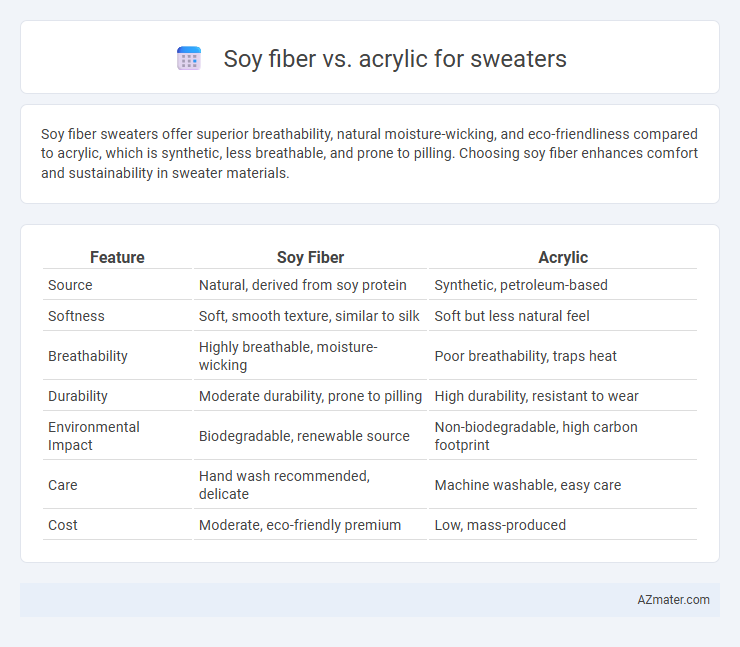Soy fiber sweaters offer superior breathability, natural moisture-wicking, and eco-friendliness compared to acrylic, which is synthetic, less breathable, and prone to pilling. Choosing soy fiber enhances comfort and sustainability in sweater materials.
Table of Comparison
| Feature | Soy Fiber | Acrylic |
|---|---|---|
| Source | Natural, derived from soy protein | Synthetic, petroleum-based |
| Softness | Soft, smooth texture, similar to silk | Soft but less natural feel |
| Breathability | Highly breathable, moisture-wicking | Poor breathability, traps heat |
| Durability | Moderate durability, prone to pilling | High durability, resistant to wear |
| Environmental Impact | Biodegradable, renewable source | Non-biodegradable, high carbon footprint |
| Care | Hand wash recommended, delicate | Machine washable, easy care |
| Cost | Moderate, eco-friendly premium | Low, mass-produced |
Introduction to Soy Fiber and Acrylic Sweaters
Soy fiber sweaters offer a sustainable and biodegradable alternative made from natural soybean protein, providing breathability, softness, and moisture-wicking properties ideal for comfort and eco-conscious fashion. Acrylic sweaters, composed of synthetic polymer fibers, deliver durability, vibrant color retention, and resistance to wrinkles and moths, making them a popular choice for affordable and easy-care knitwear. Comparing these materials highlights soy fiber's natural origin and environmental benefits versus acrylic's synthetic resilience and cost-effectiveness in sweater production.
Origins and Production Processes
Soy fiber, derived from soybean protein, undergoes a chemical process to transform the natural protein into a soft, biodegradable textile fiber, making it an eco-friendly alternative. Acrylic, a synthetic fiber made from polymerized acrylonitrile derived from petroleum, is produced through a complex chemical extrusion process that creates a durable and lightweight material. The sustainable origins of soy fiber contrast with the petroleum-based production of acrylic, highlighting key differences in environmental impact and resource utilization.
Texture and Comfort Comparison
Soy fiber sweaters offer a silky, smooth texture that feels soft and breathable against the skin, making them highly comfortable for sensitive skin types. Acrylic sweaters tend to have a coarser texture but provide excellent warmth and durability, though they may cause itchiness or discomfort for some wearers. The natural moisture-wicking and hypoallergenic properties of soy fiber enhance overall comfort compared to the synthetic nature of acrylic.
Warmth and Insulation Properties
Soy fiber offers excellent moisture-wicking abilities and natural insulation, making sweaters warm and breathable while maintaining eco-friendliness. Acrylic fibers provide superior thermal insulation with lightweight warmth and quick-drying properties, often mimicking wool's heat retention effectively. Comparing warmth, acrylic tends to insulate slightly better in damp conditions, whereas soy fiber excels in comfort and temperature regulation through natural breathability.
Durability and Longevity
Soy fiber sweaters offer moderate durability due to their natural cellulose structure, which provides breathability but may weaken over time with frequent washing. Acrylic fibers are synthetic and renowned for high durability, retaining shape and color even after multiple washes, making them ideal for long-lasting sweaters. Choosing between soy fiber and acrylic depends on prioritizing eco-friendliness and comfort versus a more resilient, low-maintenance garment.
Breathability and Moisture Management
Soy fiber offers superior breathability due to its natural cellulose structure, allowing better air circulation in sweaters compared to acrylic's synthetic composition. Moisture management in soy fiber is enhanced by its ability to absorb and release moisture efficiently, keeping the skin dry and comfortable. Acrylic fibers tend to trap heat and moisture, which can result in less breathability and increased sweat retention during wear.
Eco-Friendliness and Sustainability
Soy fiber, derived from natural soybean protein, offers superior eco-friendliness due to its renewable, biodegradable properties and reduced carbon footprint compared to synthetic fibers. Acrylic, a petroleum-based synthetic fiber, presents significant environmental concerns due to its non-biodegradability and reliance on fossil fuels, contributing to microplastic pollution and higher greenhouse gas emissions. Choosing soy fiber over acrylic for sweaters supports sustainable textile production by minimizing ecological impact and promoting resource-efficient manufacturing.
Care and Maintenance Requirements
Soy fiber sweaters require gentle washing with mild detergents and air drying to maintain softness and durability, as they are prone to shrinkage and loss of texture when exposed to heat. Acrylic sweaters are more resilient to frequent washing and can generally be machine washed on a gentle cycle, but they should be dried flat to prevent stretching and pilling. Both materials benefit from avoiding high heat during washing and drying to preserve fiber integrity and appearance.
Cost and Market Availability
Soy fiber sweaters tend to be more expensive than acrylic due to the natural, sustainable production process and limited large-scale manufacturing. Acrylic sweaters dominate the market with widespread availability and lower costs, making them a budget-friendly option for consumers. Retailers often stock a larger variety of acrylic garments because of the fiber's durability and mass-production efficiency.
Final Verdict: Choosing the Best Fiber for Sweaters
Soy fiber offers superior breathability, moisture-wicking, and eco-friendly properties, making it ideal for lightweight, comfortable sweaters. Acrylic excels in durability, color retention, and affordability, often favored for warm, easy-care sweaters with long-lasting vibrancy. For sustainable fashion and comfort, soy fiber is preferable, while acrylic suits those prioritizing durability and budget.

Infographic: Soy fiber vs Acrylic for Sweater
 azmater.com
azmater.com